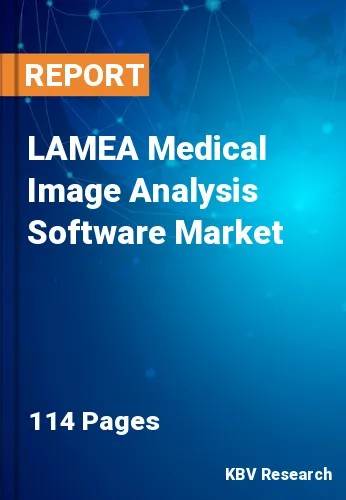The Latin America, Middle East and Africa Medical Image Analysis Software Market would witness market growth of 14.9% CAGR during the forecast period (2022-2028).
Computer-aided diagnosis (CAD) aims to provide a computer-assisted data interpretation method. In CAD image analysis, initial detection, image feature extraction, image augmentation, and image segmentation are all included. This method aids radiologists in reducing manual data interpretation inaccuracies and identifying issues typically missed during manual analysis processes.
This technique was initially created for mammographic image processing but has since been expanded to encompass the detection and analysis of prostate, liver, lung, and colon cancers. These factors, as well as the increase in disease prevalence, improvement in healthcare infrastructure, and rise in healthcare spending power, are driving the market's expansion.
The demand for ultrasonic imaging solutions is anticipated to expand due to radiologists' and doctors' increasing need for integrated software solutions and 3D imaging. In addition, the advantages of ultrasound imaging software, such as effective diagnosis, quick image enhancement, point-to-point measuring, contour detection, picture restoration, and many other characteristics, have been registering a wide utilization, boosting the medical image analysis market's revenue.
The number of traffic accidents in the Gulf Cooperation Council (GCC) has become a matter of public health. The region's high death rate—more than double that of western countries—is linked to a large number of road accident incidents. There have been 160% more traffic accidents in Qatar in the last ten years. Although most road accident injuries occur in the 10 to 40-year age range, pediatric age groups account for a higher percentage of musculoskeletal injuries. The need for modern medical technologies, particularly those connected to advanced diagnostic imaging systems, is increasing due to the region's increased rate of injuries from traffic-related accidents. This would lead to a rise in the use of medical image analysis tools in the region.
The Brazil market dominated the LAMEA Medical Image Analysis Software Market by Country in 2021, and would continue to be a dominant market till 2028; thereby, achieving a market value of $115.8 million by 2028. The Argentina market is experiencing a CAGR of 15.5% during (2022 - 2028). Additionally, The UAE market would display a CAGR of 14.6% during (2022 - 2028).
Based on Type, the market is segmented into Integrated and Standalone. Based on Modality, the market is segmented into Computed Tomography, Ultrasound, Magnetic Resonance Imaging, Combined Modalities and Others. Based on End User, the market is segmented into Hospitals, Diagnostic Centers and Others. Based on Application, the market is segmented into Cardiology, Orthopedic, Neurology, Dental, Oncology and Others. Based on countries, the market is segmented into Brazil, Argentina, UAE, Saudi Arabia, South Africa, Nigeria, and Rest of LAMEA.
Free Valuable Insights: The Worldwide Medical Image Analysis Software Market is Projected to reach USD 6.6 Billion by 2028, at a CAGR of 11.4%
The market research report covers the analysis of key stake holders of the market. Key companies profiled in the report include Canon, Inc. (Canon Medical Systems Corporation), Koninklijke Philips N.V., GE HealthCare Technologies, Inc., Siemens Healthineers AG (Siemens AG), Spacelabs Healthcare (OSI Systems, Inc.), Agfa-Gevaert Group, MIM Software, Inc., Esaote SpA, Aquilab SAS (Coexya), and Merative L.P. (Francisco Partner).
By Type
By Modality
By End User
By Application
By Country
Our team of dedicated experts can provide you with attractive expansion opportunities for your business.

